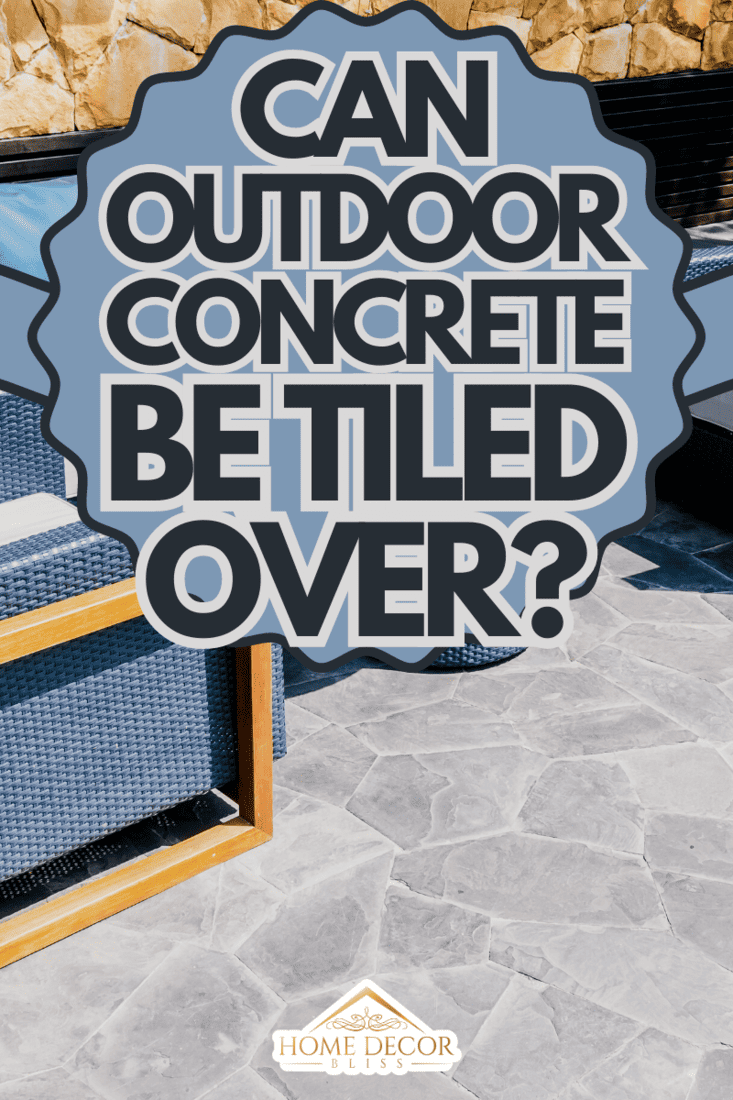When you're considering enhancing your outdoor space, one option you might come across is tiling over your existing concrete.
This approach can provide an attractive and durable surface for outdoor areas like patios, walkways, or steps.
You may wonder if it's possible and what steps you need to follow to successfully achieve this transformation.
Luckily, you can indeed tile over outdoor concrete with the right preparation and approach.
It's important to properly prepare the concrete, select the appropriate tiles for outdoor use, and follow the correct installation process.
In this article, we'll provide valuable tips and insights to help you transform your outdoor concrete area into a beautiful tiled space.

Can You Tile Over Outdoor Concrete?

Yes, you can tile over outdoor concrete, but it requires proper preparation and the right materials for a successful installation.
Firstly, clean your concrete surface thoroughly to ensure nothing prevents the tile from adhering properly.
Use a slip-resistant tile, such as porcelain, that's rated for outdoor use to increase durability and reduce water absorption.
Apply a waterproofing membrane, like RedGard, to the concrete slab before you begin tiling to protect it from moisture.
Try this 3.5-gallon RedGard waterproofing on Amazon.
When laying the tiles, consider using an uncoupling membrane or installing a cement board on the concrete first. This helps prevent tile work from becoming loose if the underlayment flexes.
During the installation process, protect your knees and hands by wearing knee pads and gloves, as tiling can be physically demanding.
Remember to take breaks when needed and maintain a steady pace to ensure a professional finish.
Benefits of Tiling Over Concrete

Tiling over outdoor concrete can not only enhance the appearance of your space but also improve its durability and require less maintenance.
Let's dive into these benefits in more detail.
Increased Aesthetic Appeal
Tile flooring can instantly elevate the look of your outdoor areas.
With a wide variety of designs, textures, and colors, you can create a customized and attractive surface that suits your style.
Improved Durability
Outdoor tiles are designed to withstand exposure to weather and foot traffic.
By installing them over concrete, you can create a long-lasting, hard-wearing surface that resists damage and wear.
Low Maintenance
Compared to other outdoor flooring options, tiles require minimal maintenance. Simply sweep, hose down, or use mild cleaning solutions to keep your tiled surface looking its best.
How Do I Prepare Concrete F\for Tile?
Preparing concrete for tile installation involves a few essential steps to ensure proper bonding and longevity.
Cleaning the Surface
The first step in preparing concrete for tile is cleaning the surface.
Remove dirt, debris, and any existing paint or sealant by using a pressure washer or a heavy-duty cleaner followed by a thorough rinse.
Allow the cleaned surface to dry completely before moving on to the next step. A clean and dry surface is crucial for proper adhesion of the tile to the concrete.
Checking the Concrete's Condition
Inspect the concrete for any signs of damage or unevenness. If you notice any low spots, use a self-leveling compound to create a smooth, level surface.
Examine the concrete for excessive moisture, as this can lead to tile delamination. Address any moisture issues before proceeding with tile installation.
Fixing Cracks and Holes
Repair any cracks and holes in the concrete with a suitable patching compound. Follow the product instructions for the best results.
Once the repairs have cured, consider applying a crack isolation membrane to prevent future problems.
This membrane will help protect the tile installation from any potential movement in the concrete.
Choosing the Right Tile
When selecting tiles for your outdoor concrete, it's essential to consider various factors to ensure the best performance and appearance.
Considering Climate Factors
Outdoor tiles must withstand weather changes and extreme temperatures.
Think about the climate your project may encounter when making your selection. For instance, the material should have a low absorption rate and provide a slip-resistant surface. This is critical for areas prone to rain, frost, or snow.
Types of Suitable Tiles
There are several tile options that work well on outdoor concrete.
Choosing the appropriate material can help minimize maintenance and prolong the life of your project.
Outdoor Porcelain Tile: Porcelain tiles are hard-wearing, resistant to water absorption, and suitable for outdoor use.
Natural Stone Tile: Natural stone tiles offer a beautiful appearance but can be expensive. Shipping and installation costs can be significantly higher.
Concrete Tile: When seeking a lower-cost alternative to natural stone, consider concrete tiles. They mimic the appearance and texture of stone while offering durability and a more affordable price tag.
Installation Process
When tiling over outdoor concrete, the process is straightforward if you follow the necessary steps diligently.
Your work will involve three major stages, which we detail below.
Applying Mortar
First, clean the concrete surface to ensure it's free of dirt and debris.
Apply a waterproofing membrane to the concrete for added protection.
When the membrane is dry, use a polymer-modified, dry-set mortar adhesive suitable for outdoor applications.
Spread it evenly over the concrete slab and apply some on the back of the tiles as well.
Laying and Spacing Tiles
Begin laying the tiles starting from a predetermined point, pressing them gently into the mortar.
Use spacers to maintain consistent spacing between each tile and ensure a professional finish.
As you work, double-check the alignment of your tiles and adjust as needed.
Leave them undisturbed for the mortar adhesive to set properly following the manufacturer's recommendations.
Grouting the Tiles
After the mortar has set, it's time to grout the tiles.
Choose a stain- and fade-resistant grout suited for outdoor use. Mix the grout according to the instructions on the package.
Check out this stain-resistant grout on Amazon.
Using a rubber grout float, apply the grout at a 45-degree angle, filling the spaces between the tiles.
Finally, clean the surface of the tiles with a damp sponge to remove any excess grout and achieve a polished look.
For more detailed instructions, you can check out this article: How To Fill Gaps Between Tiles [Using Grout, Caulk, Gap Filling Powder, Or White Cement]
Do You Need Underlayment for Tile on Concrete?
When tiling over outdoor concrete, you might wonder if an underlayment is necessary.
Although it's not always required, using underlayment can provide additional strength and stability on uneven or rough substrates.
Uneven concrete and changes in temperature or humidity can cause cracks in your tile.
An underlayment helps prevent and control these cracks from spreading across your entire floor.
By smoothing out irregular spots in the subfloor, the underlayment also creates a rigid layer that inhibits floor flexing.
To ensure a successful installation, choose a trowelable underlayment containing cement and aggregate mixed with water or a latex additive.
Many manufacturers recommend applying a slurry coat of the product to the substrate, allowing it to dry until it becomes tacky before applying the mixture to the surface.
Lastly, don't forget to use a polymer-modified, dry-set mortar adhesive rated for outdoor use when installing your tiles.
Additionally, opt for grout that resists stains and fading, ensuring that your outdoor tiling project remains durable and looks great for years to come.
Can You Tile an Outdoor Patio?

Yes, you can easily tile over outdoor concrete, including your patio. Tiling can enhance your patio's appearance and add a touch of elegance to your outdoor space.
Before you begin, make sure you've got a solid base like an existing concrete slab or brick patio.
You'll need to clean your concrete base meticulously to ensure your tile adheres properly.
Depending on the specific tile and adhesive, you may also need to use a waterproof membrane.
When selecting tiles for outdoor use, consider factors such as slip resistance and durability under different weather conditions.
As you lay your tiles, remember to use proper spacing for grout lines, ensuring that water can flow freely and prevent buildup.
Proper installation will guarantee a lasting and beautiful patio you can enjoy for years to come.
Learn more from this video below.
Maintenance Tips
Proper maintenance of your outdoor tiles can enhance their longevity and appearance.
Here are some helpful tips and tricks to ensure your outdoor concrete tiles stay in tip-top condition for years to come.
How do you Keep Outdoor Tiles from Sweating?
Your outdoor tiles may sweat due to temperature fluctuations or high humidity.
By following the suggestions below, you can prevent this from happening and keep your tiles looking great.
First, always make sure your outdoor concrete is properly sealed before installing tiles. This will create a moisture barrier, preventing excess moisture from affecting the tiles.
Also, using porcelain tiles instead of ceramic tiles can be beneficial, as they are more durable and absorb water less, reducing the chances of sweating.
Regular cleaning of your tiles with a mild detergent and a soft-bristle brush can help remove any dirt or debris that may contribute to moisture build-up.
Drawbacks and Potential Problems
When considering tiling over outdoor concrete, it's important to be aware of potential issues that could arise.
One primary concern is the possibility of the concrete cracking or shifting.
As concrete moves, it can transfer this movement to the tile, causing cracks or damage.
In fact, if a cracked tile were to be removed from concrete, you would likely find the same crack pattern beneath it.
Another factor to consider is the preparation needed for a successful installation.
Applying a waterproofing membrane to the slab can help mitigate the risk of water damage, but it's an additional step in the process.
Moreover, choosing the right tile adhesive and grout is critical for outdoor use.
Opt for a polymer-modified, dry-set mortar adhesive rated for outdoor use, and for grout, select one that resists stains and fading.
Keep in mind that some types of tile, like porcelain, can be easily damaged during installation. Especially for those thinner tiles, careful handling is required to prevent breakage.
Last but not least, if there are any existing defects in the concrete, these imperfections can impact the tile's long-term durability.
Even small cracks in the concrete can lead to larger cracks or tile damage in the future.
Enhance Your Outdoor Space By Tiling Over Concrete
You can definitely tile over outdoor concrete provided that you prepare the concrete surface properly.
Cleaning and using a concrete floor etcher are essential steps in this process.
When tiling outside on concrete, make sure to choose tiles rated for outdoor use that have a slip-resistant surface, such as porcelain.
Additionally, use an adhesive and grout capable of withstanding stains, fading, and outdoor elements to ensure your project stays in great condition for years to come.







